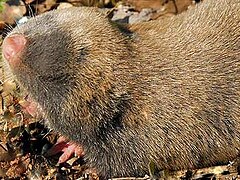Lesser blind mole-rat
| Lesser blind mole-rat | |
|---|---|

| |
| Scientific classification | |
| Domain: | Eukaryota |
| Kingdom: | Animalia |
| Phylum: | Chordata |
| Class: | Mammalia |
| Order: | Rodentia |
| Family: | Spalacidae |
| Genus: | Nannospalax |
| Species: | N. leucodon
|
| Binomial name | |
| Nannospalax leucodon (Nordmann, 1840)
| |

| |
| Synonyms | |
|
Spalax leucodon Nordmann, 1840 | |
The lesser blind mole-rat (Nannospalax leucodon) is a species of rodent in the family Spalacidae. It is found in Albania, Bosnia and Herzegovina, Bulgaria, Croatia, Greece, Hungary, North Macedonia, Moldova, Romania, Serbia, Montenegro, Turkey and Ukraine.[2]
Prior to 2012, it was classified in the genus Spalax, but modern authors tend to separate this and some closely related mole rat species into a separate genus named Nannospalax. A study of the dentition showed that Nannospalax leucodon is a superspecies consisting of several cryptic species that can be distinguished by the caries in their teeth. According to this definition there are four separate "cariological" forms in the Carpathian Basin, one of them endangered and another one vulnerable while insufficient data are available to evaluate the conservation status of the other two forms.[3]
Blind mole-rats are not in fact completely blind as they do possess simple eyes 1mm in diameter and located under a layer of skin and fur. They act effectively as light meters, only sensing the level of available light.[4]
The lesser blind mole-rat was declared to be extinct in Croatia in 1984, having been present in the area of Srijem up until the 20th century, but its continued presence in Vučedol was confirmed in 2023.[5]
One study directed towards life expectancy used this species by virtue of its incredible longevity performance, hypoxia and hypercapnia endurance, as well as cancer resistance. Looking at the fecal and skin samples of this ideal candidate, it was found that the Muribaculaceae bacterial family, known to be linked with longevity, dominated fecal samples.[6]
References
- ^ Kryštufek, B. & Amori, G. (2017) [amended version of 2008 assessment]. "Nannospalax leucodon". IUCN Red List of Threatened Species. 2017: e.T14328A113301882. doi:10.2305/IUCN.UK.2017-1.RLTS.T14328A113301882.en. Retrieved 7 March 2022.
- ^ "Nannospalax leucodon (Nordmann, 1840)". www.mammaldiversity.org. Retrieved 2022-03-07.
- ^ KRYŠTUFEK, BORIS; IVANITSKAYA, ELENA; ARSLAN, ATILLA; ARSLAN, EMINE; BUŽAN, ELENA V. (2011-10-31). "Evolutionary history of mole rats (genus Nannospalax) inferred from mitochondrial cytochrome b sequence". Biological Journal of the Linnean Society. 105 (2): 446–455. doi:10.1111/j.1095-8312.2011.01795.x. ISSN 0024-4066. S2CID 83596816.
- ^ Kashash, Yael; Smarsh, Grace; Zilkha, Noga; Yovel, Yossi; Kimchi, Tali (2022). "Alone, in the dark: The extraordinary neuroethology of the solitary blind mole rat". eLife. 11. doi:10.7554/eLife.78295. PMC 9177142. PMID 35674717.
- ^ "Veliko otkriće na Vučedolu, pronađen glodavac kojeg se smatralo izumrlim: 'Pojeo nam je svo povrće!'". www.jutarnji.hr. 17 March 2023. Retrieved 2023-03-17.
- ^ Altuntas, E., Yildirim, B., Ozturk, G., Yildirim, S., Sibai, M., Altuntaş, E., Yıldırım, B., Öztürk, G., Yıldırım, S., & Demircan, T. (2020). Microbiome and Longevity: High Abundance of Longevity-Linked Muribaculaceae in the Gut of the Long-Living Rodent Spalax leucodon. Omics : a Journal of Integrative Biology., 24(10), 592–601. https://doi.org/10.1089/omi.2020.0116
- Musser, G.G.; Carleton, M.D. (2005). "Superfamily Muroidea". In Wilson, D.E.; Reeder, D.M (eds.). Mammal Species of the World: A Taxonomic and Geographic Reference (3rd ed.). Johns Hopkins University Press. pp. 894–1531. ISBN 978-0-8018-8221-0. OCLC 62265494.
- Németh A, Révay T, Hegyeli Z, Farkas J, Czabán D, Rózsás A, Csorba G 2009. Chromosomal forms and risk assessment of Nannospalax (superspecies leucodon) (Mammalia: Rodentia) in the Carpathian Basin Archived 2017-08-13 at the Wayback Machine Folia Zoologica, 58(3), 349–361.
- Articles with short description
- Short description is different from Wikidata
- IUCN Red List data deficient species
- Articles with 'species' microformats
- Webarchive template wayback links
- Nannospalax
- Mammals described in 1840
- Taxa named by Alexander von Nordmann
- Taxonomy articles created by Polbot
- All stub articles
- Muroid rodent stubs


